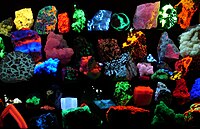
Photo from wikipedia
Optical absorption in amorphous tungsten oxide ($\textit{a}\mathrm{WO}_{3}$), for photon energies below that of the band gap, can be rationalized in terms of electronic transitions between localized states. For the study… Click to show full abstract
Optical absorption in amorphous tungsten oxide ($\textit{a}\mathrm{WO}_{3}$), for photon energies below that of the band gap, can be rationalized in terms of electronic transitions between localized states. For the study of this phenomenon, we employed the differential coloration efficiency concept, defined as the derivative of the optical density with respect to the inserted charge. We also made use of its extension to a complex quantity in the context of frequency-resolved studies. Combined $\textit{in situ}$ electrochemical and optical experiments were performed on electrochromic $\textit{a}\mathrm{WO}_{3}$ thin films for a wide lithium intercalation range using an optical wavelength of $810~\mathrm{nm}$ ($1.53~\mathrm{eV}$). Quasi-equilibrium measurements were made by chronopotentiometry (CP). Dynamic frequency-dependent measurements were carried out by simultaneous electrochemical and color impedance spectroscopy (SECIS). The differential coloration efficiency obtained from CP changes sign at a critical intercalation level. Its response exhibits an excellent agreement with a theoretical model that considers electronic transitions between $\mathrm{W}^{4+}$, $\mathrm{W}^{5+}$, and $\mathrm{W}^{6+}$ sites. For the SECIS experiment, the low-frequency limit of the differential coloration efficiency shows a general trend similar to that from CP. However, it does not change sign at a critical ion insertion level. This discrepancy could be due to degradation effects occurring in the films at high $\mathrm{Li}^+$ insertion levels. The methodology and results presented in this work can be of great interest both for the study of optical absorption in disordered materials and for applications in electrochromism.
Journal Title: Journal of Applied Physics
Year Published: 2020
Link to full text (if available)
Share on Social Media: Sign Up to like & get
recommendations!